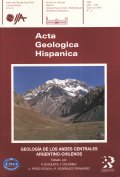El Segmento de Subducción Subhorizontal de los Andes Centrales Argentinos-Chilenos
Abstract
The westem active margin of South America, characterized by the Andes mountain chain, shows a high variability along strike. Different segments have a diverse topography, cmstal roots and surface geology. Among these segments the flat-slab segment of the southem Central Andes, depicts a remarkable geology between 28" and 33"s. The lack of an active volcanism due to the subhorizontal subduction and the strong coupling between the Nazca plate and the South America plate, have produced the highest mountains in the Andes, with mount Aconcagua, almost 7,000 m a.s.1. This segment is also characterized by the thin-skinned fold and thrust belt of Precordillera, and the Sierras Pampeanas, broken foreland basement blocks uplifted during the Andean orogeny.
These characteristics controlled the excellent exposures of this amagmatic segment, without a late Cenozoic volcanic cover along the axial part of the Principal Cordillera. Therefore, most of the stmctures that produced the present uplift can be identified. On that bases, severa1 conceptual models have tied to explain the deep stnicture of the orogen, although the lack of deep seismic information hinders the evaluation of the mechanisms that produced the present orogenic shortening. A deep seismic reflection sounding will provide information to answer many of the questions that relate subduction to mountain building in one of the best sections of an Andean-type orogen.


